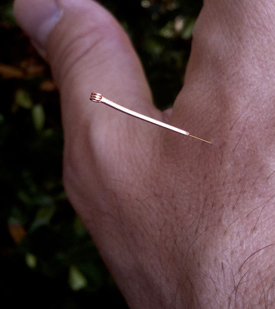A new MRI study measured the pain relieving effects of gold acupuncture needles and revealed that acupuncture limits brain responses to pain.  Researchers used blood oxygen level dependent fMRI (functional magnetic resonance imaging) on human volunteers receiving pain stimulation. Without acupuncture, fMRI imaging demonstrated widespread global responses to pain throughout the brain. With acupuncture, the researchers discovered acupuncture reduces responses to pain to very small, limited regions of the brain. This new fMRI brain mapping contributes to a greater understanding of the biological mechanisms involved in the analgesic effects of acupuncture.
Researchers used blood oxygen level dependent fMRI (functional magnetic resonance imaging) on human volunteers receiving pain stimulation. Without acupuncture, fMRI imaging demonstrated widespread global responses to pain throughout the brain. With acupuncture, the researchers discovered acupuncture reduces responses to pain to very small, limited regions of the brain. This new fMRI brain mapping contributes to a greater understanding of the biological mechanisms involved in the analgesic effects of acupuncture.
The new scientific research was a result of a collaborative effort between the Zhejiang Sci-Tech University, Hangzhou; and the University of Traditional Chinese Medicine, Hangzhou. Participants showed brain responses to pain perception without acupuncture affecting nearly the entire brain including the “thalamus, hypothalamus, reticular formation of brain stem, limbic system, cerebral cortex and other parts.” The addition of acupuncture point LI4 (Hegu), located on the hand, limited the brain region responses to more specific, smaller and isolated areas of the brain: “precentral gyrus, the left of inferior corpus callosum, the right of thalamus, middle occipital gyrus, the right of cingulate gyrus, the left of caudate nucleus, fusiform gyrus, hippocampus, the left of superior temporal gyrus, middle temporal gyrus, supramarginal gyrus, angular gyrus, left of the superior parietal lobule and inferior parietal lobule.” The researchers used a Siemens 1.5T Megneton Sonata for MRI imaging. Acupuncture needles applied to LI4 were composed of 75% gold and were 40mm X .32mm.
The researchers also compared the analgesic affects of needle-free acupuncture point stimulation with an electrical device. Using TEAS (transcutaneous electric acupoint stimulation) at LI4, the researchers discovered two major findings. First, TEAS reduced brain responses to pain and produced an analgesic effect. Secondly, acupuncture needle stimulation of LI4 produced a greater reduction in brain responses to pain than non-needle TEAS. The researchers noted that manual acupuncture needle stimulation has wider and stronger effects on brain responses to pain than TEAS. The researchers concluded that acupuncture “is an effective means in pain relief.”
Gold Acupuncture Needles
The researchers chose gold needles for the study although acupuncture needles are often made from stainless steel, silver and other metals and alloys. Gold needles are associated with hypoallergenic properties. In Traditional Chinese Medicine, gold acupuncture needles are sometimes associated with Yang and tonifying properties. Modern research confirms that the impedance at electric terminal points is affected by the type of metal used in the manufacture of a needle. Historically, gold needles have been found in numerous archeological discoveries. The tomb of prince Liu Sheng (d. 113 BCE), unearthed in 1968, contained both gold and silver acupuncture needles. Liu Sheng was the son of Emperor Jing Di, ruler during the western Han Dynasty.
Scientific Equiptment
The researchers note that acupuncture was first used for surgical anesthesia in the 1950s. In an effort to understand the scientific phenomena of acupuncture analgesia, several modern techniques have successful measured the biochemical and electro-biochemical effects of acupuncture needle stimulation. The researchers note that this technology includes the electroencephalograph (EEG), magnetoencephalograph (MEG), positron emission tomography (PET) and fMRI. The researchers note that this most recent study and other studies have demonstrated objective scientific proof that acupuncture “is an effective means in pain relief.” This latest study demonstrated that TEAS is effective at acupuncture point LI4 but that its effects were mainly limited to the activation of the right side of the cerebral cortex whereas manual acupuncture at LI4 had a more global effect.
Reference:
Yang, Jia-Min, Xiao-Yu Shen, Ling Zhang, Song-Xi Shen, Dan-Dan Qi, Shi-Peng Zhu, Li Luo et al. "The effect of acupuncture to SP6 on skin temperature changes of SP6 and SP10: An observation of Deqi‟."


